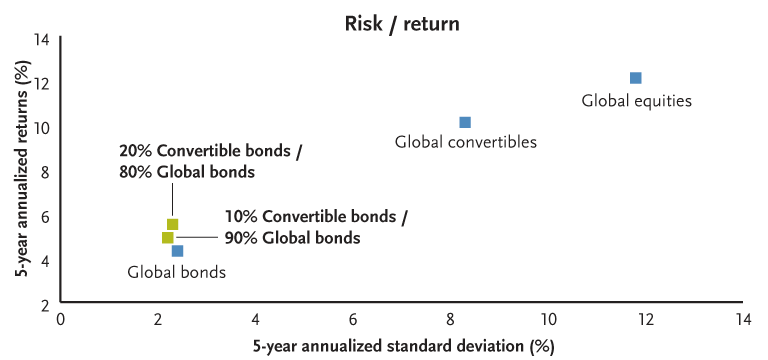Convertible Bonds Convertible Bond Fund Convertible Bond Pricing Your
Post on: 17 Август, 2015 No Comment

Convertibles. No, we’re not talking about the Dodge Viper that you’ve been eyeing at the local car dealership. Convertible bonds are simply bonds that can be later converted into stock.
Convertible bonds are bonds issued by a company that are convertible into common stock. Like all bonds, they also provide a yield (interest). However, this yield is also slightly lower than most corporate bonds (bonds issued by a company) offer. The current average yield is about 4%.
In a way, convertible bonds act much like a mix between equities (stocks) and bonds. If the price of the stock goes up, so does the bond. The bond price usually goes up about 2/3 as much as the stock did. When the stock declines, so does the bond but the bond usually does not depreciate more than 1/2 as much as the stock did.
When a convertible bond is purchased, it is given a conversion ratio. This simply states how many shares of stock the bond can be converted into per $1000. If the conversion ratio is 20:1 (20 to 1), then the bond can be converted into 20 shares of the stock at a price of $50 each. However, the conversion price is often valued above (also called premium to) the current stock price by 10-30%. This means that the stock may be trading at 40 or 45. Therefore, the stock would have to go up until it reaches 50 before a reasonable conversion can take place. If the stock kept going up and reached 60/share, then the bond could be converted into $1200 worth of stock. This may seem a little confusing now but it is really rather basic once you get the hang of it.
Advantages These bonds offer a way to cushion the market fluctuations while providing you with a very nice annual gain. In the past 10 years, convertible bonds have returned an average of 13% versus the S&P 500’s return of 18%.Another advantage is that these bonds also offer a way to receive income from many technology stocks. As well known, many technology stocks do not offer dividends, thus not providing for any income. By investing in convertible bonds, an investor can receive income in the form of the yield.Many convertible bonds are offered by small and medium-sized companies which allow investors a slightly safer approach to getting into the small and mid-cap sectors.Disadvantages Unfortunately, these bonds do have disadvantages. First of all, the convertibles trade at a premium to the current trading price. To make the conversion effective, you would have to allow the stock to reach the conversion price. If the stock never reaches that price, the conversion would be worthless but the bond would continue to produce interest.These bonds are also rather expensive and hard to get a hold of. For the average investor, it may cost $50,000-$100,000 to produce a diversified portfolio of these bonds. That is why we recommend you purchase them through mutual funds .Finally, most convertible bonds are also callable. This means that the company may force the bondholders to convert into stock. This does happen but not very often. The company does this to limit their debt. Bonds are referred to as debt because the money is leant to the company by the bondholder and the company has the obligation to pay them back plus interest.If you are interested in these bonds, you would definitely want to look into mutual funds. Because these bonds are often rather expensive and difficult for the average and beginning investor to purchase, mutual funds offer these investments, usually through low minimum investments. One such mutual fund. Calamos Convertible A, has a low minimum investment of only $500 and a 10-year return of 13.45%.These bonds are a great way to provide a nice long-term return with a little less risk. Through mutual funds, a young investor can diversify their portfolio while not missing out on the excellent gains associated with a bull market .
Previous Article — Next Article Like this article? Bookmark It














